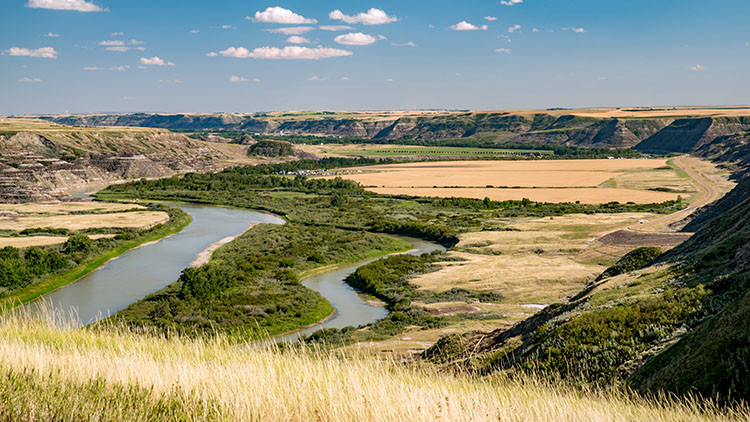Government mail service may be affected by the Canada Post labour disruption. Learn about how critical government mail will be handled.
Partners in drought mitigation

When it comes to water, we are all in it together. Alberta’s government is working closely with communities, water users and all our partners, to take strong action to prepare for drought and reduce the future risks to Alberta.
Alberta’s Drought Response Plan
To help Albertans better understand and respond to the conditions in their area, Alberta’s updated Drought Response Plan now classifies drought stages by river basin, or even sub-basin, and an online map helps the public easily understand conditions in their community.
Check drought conditions in your area: Latest updates
Review the plan: Alberta’s Drought Response Plan
Download the fact sheet: Drought Response Plan fact sheet
The Drought Response Plan is a multi-stage roadmap, covering everything from conservation plans and water-sharing agreements to declaring an emergency and prioritizing water for human health and safety. Alberta’s criteria for assessing the severity drought conditions and corresponding management actions has not changed. The only change is that each basin now receives its own specific conditions ranking.
The plan outlines:
- the stages of Alberta’s drought response
- roles and responsibilities of partners, including government, to help everyone collaborate and communicate
- regulatory and non-regulatory approaches and tools that may be used in various drought conditions
- how and when emergencies would be declared as a last resort
Plan objectives
Alberta’s Drought Response Plan outlines the government’s actions during all stages of drought response. The objectives of the plan are:
- Protecting the health and safety of Albertans from the impacts of drought.
- Minimizing the impacts of drought on Alberta’s communities, economy and the environment.
- Implementing a proactive, risk-based approach, to rapidly assess, prepare for and respond to the impacts of a drought.
- Ensuring response to drought conditions are agile and adjusted in real time as information changes.
- Enabling all Albertans to take appropriate action, to conserve water and work together.
Declaring an emergency under the Water Act
Under the Drought Response Plan, Alberta would only declare an emergency under the Water Act as a last resort. Alberta has never declared an emergency under the Water Act. The 3 triggers that may lead to an emergency declaration are:
- If there is not sufficient water available for the priority uses - human health and safety is the top priority, followed closely by ensuring sufficient water supplies for critical infrastructure, livestock welfare and critical environmental needs.
- If there is increasing distress from local authorities or if local authorities are unable to respond to issues caused by drought. For example, if a state of local emergency is declared or if the Provincial Emergency Coordination Centre is activated at level 3 or higher.
- If Alberta’s water management system becomes so overwhelmed that the number of requests for water cannot be addressed.
Emergency declarations are temporary and allow the government to prioritize water uses. They do not replace the regulatory requirements of the Water Act and would only apply to a specific location.
Priority uses for water in an emergency
In the event that Alberta declares an emergency under the Water Act, water use for human health and safety is the top priority, followed closely by ensuring sufficient water supplies for critical infrastructure, livestock welfare and critical environmental needs.
Human health and public safety
- Drinking water
- Potable water for cleaning, bathing and cooking
- Water for health care facilities
- Maintaining adequate pressure in municipal distribution and wastewater collection systems
Critical infrastructure
- Power plant operations essential to maintain core service levels and electricity grid stability
- Emergency services (for example, maintaining fire flow pressure within municipalities)
Critical environmental needs
- Prevent the loss of a species at risk or associated critical habitat
- Flow to dilute wastewater releases
Livestock welfare
- Livestock watering
- Disease prevention and containment
Supporting water licence holders and Albertans
Finding long-term solutions
2024 drought response
Resources
Contact
Connect with Environment and Protected Areas’ Outreach Services:
Hours: 8:15 am to 4:30 pm (open Monday to Friday, closed statutory holidays)
Toll free: 310-3773 (in Alberta)
Email: [email protected]